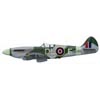| Author / Post |

|
 alanrrrm
alanrrrm

Basic Member
|
Joined: March/27/2013
 United Kingdom United Kingdom
Posts: 1
IP Logged
|
| Posted: April/06/2013 at 6:55am |
Quote
|
|
Hi, Guys and Gals,
I am new here, and returning to proper building (rather than ARTF), thanks to easing into retirement. When I built proper models last, Keil Kraft and Veron were in their heyday, but now I need to use my brain.
Have bought an excellent Mick Reeves one quarter scale Camel, and I can get my mind round most of this - but my main task is going to be to bend wire smoothly round curves. Most or all trailing edges and wingtips are 16 swg piano wire, as are the entire fin and rudder outlines.
I have a wire bender, but it does angles, rather than curves.
I have visited various forums (and apologies if this has been covered in a forum here, and I am just setting out to explore the site), but many tend to focus on undercarriages, and specific angles, rather than 2-3 inch diameter curves.
I have tried bending around jam jars, cans, etc., and the wire ends up in the most interesting undulating shapes. Never flowing, and never (ever), ultimately, in the right direction/ plane.
Does anyone have a definitive method to make sweeping curves for a MR kit?
Is the answer to make hard wood blanks (probably with tighter curves, to allow for the wire springing out again)? Or do I tap guide nails into a vermiculite board, and shape the wire around these with a blow torch?
I think probably the latter, but how does one avoid the metal going brittle?
All thoughts welcome and thanks in anticipation!!!
|
| Back to Top Printer Friendly Version Profile
Search
|
| |

|
 davidq
davidq

Site Supporter
|
Joined: September/01/2004
 United Kingdom United Kingdom
Posts: 2972
IP Logged
|
| Posted: April/06/2013 at 7:15am |
Quote
|
|
Welcome to the best scale modeling site on the web. You have most likely found the Mick Reeves forum by now and have found at the top of the list Lee's Camel build where the first few pages will help you a lot. I would urge you to dip into you wallet and become a Site Supporter, this will enable you to start your own build thread, it's not very difficult and most rewarding. You will never regret it as the help and advice available here is second to none.
Dave.
__________________
Danger Balsa dust is addictive.
Flying Bryant Bulldog,SE5a.BT MkIX Spitfire, FW190, P47. P51. Corsair
Under construction. Dave Wigley Wyvern. BT Valiant,Typhoons JB Dauntless
Waiting BT Spitfire
|
| Back to Top Printer Friendly Version Profile
Search
|
| |

|
 Dave Miller
Dave Miller

Basic Member
|
Joined: November/16/2012
 United Kingdom United Kingdom
Posts: 300
IP Logged
|
| Posted: April/06/2013 at 7:30am |
Quote
|
|
Welcome to the forum Alan, I second Dave's suggestion as I too have been following Lee's build thread with interest.
__________________
Dave
|
| Back to Top Printer Friendly Version Profile
Search
|
| |

|
 J_Whitney
J_Whitney

Moderator Group
|
Joined: November/10/2003
 United States United States
Posts: 7409
IP Logged
|
| Posted: April/06/2013 at 10:28am |
Quote
|
|
Hello Alan and welcome to RCSB/ David is right,take a look at Lee's thread, and there are a couple others going on now too. But my first thought was the same as your last sentance - make a full size pattern and pull the wire around that - I would think it would not have to be fully formed to the curve but that fixing it to the TE of the ribs would hold it in place.
And he is also correct about becoming a site supporter - it is amazing how much help you will get and how many friends you will make.
http://www.rcscalebuilder.com/page_display.asp?pid=5
__________________
Jeff
Castro Valley, CA
The essential paradox of our democracy is that our warriors fight and die for our right to dispute the cause for which they are fighting and dying.
Let me know if I can help
|
| Back to Top Printer Friendly Version Profile
Search
|
| |

|
 blueman
blueman

Basic Member
|
Joined: December/07/2007
 United States United States
Posts: 23
IP Logged
|
| Posted: April/06/2013 at 11:44am |
Quote
|
|
Howdy Alan,
Just a thought . I have used three pegs set in line into a wooden board. Wire is then pulled through with a set of grips and pushed from behind as not to pull the bend out. The closer the pegs are together, the tighter the curve. Trial and error will tell me how for apart to make the pegs to achieve a proper curve. Industrial benders work in this fashion utilizing rollers. Hope this helps.
James
__________________
Bumpsidaisy, Its enough to make ya weep.
|
| Back to Top Printer Friendly Version Profile
Search
|
| |

|
 lee3503
lee3503

Lifetime Site Supporter
|
Joined: November/19/2009
 United Kingdom United Kingdom
Posts: 748
IP Logged
|
| Posted: April/06/2013 at 12:05pm |
Quote
|
|
Hi Alan,
I found the only way to bend the wire was by hand, as I'm sure you've found out, It's piano wire and very tough, if you try to use formers it just springs back out and is really difficult to judge.
Just bend it with your hands and keep comparing it with the plans, you need to get a good shape because you don't want it under any tension when fitted to the wooden parts.
Lee
|
| Back to Top Printer Friendly Version Profile
Search
|
| |

![]](/skins/text/forum_images/header-bg.gif)

![]](/skins/text/forum_images/header-bg.gif)